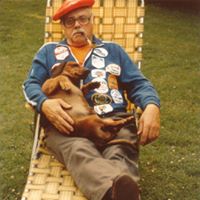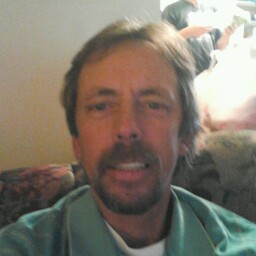Douglas P Crane
from Hobart, IN
Douglas Crane Phones & Addresses
- Hobart, IN
- San Pablo, CA
- 6510 Hazel Ave, Richmond, CA 94805 • 6263983290
Work
-
Company:Madera millOct 1990
-
Position:Sales and customer service
Name / Title
Company / Classification
Phones & Addresses
President
Crane Roofing Inc
Roofing/Siding Contractor
Roofing/Siding Contractor
1460 Maria Ln, Walnut Creek, CA 94596
All Gutter Service
Roofing/Siding Contractor
Roofing/Siding Contractor
221 Commercial St, Vallejo, CA 94589
President
C.P.R. PAINTING, INC
633 Vintage Vly Dr, Fairfield, CA 94534
Us Patents
-
Interactive Audiovisual Control Mechanism
view source -
US Patent:50653458, Nov 12, 1991
-
Filed:Aug 21, 1990
-
Appl. No.:7/570961
-
Inventors:Lance Knowles - San Francisco CA
Douglas Crane - Portola Valley CA -
Assignee:DynEd International, Inc. - San Francisco CA
-
International Classification:G06F 1518
G09B 704 -
US Classification:395154
-
Abstract:An Interactive Audiovisual Control Mechanism (IACM) which, by exploiting recent advances in CD technology which permit rapid random access of discrete audio information (such as an individual sound or utterance), provides for the first time an interactive computer system in which large amounts of high quality audio and video are presented to the user simultaneously. In the preferred embodiment, this is accomplished via random access to both CD/ROM and VD devices, wherein individual visual frames of the VD are displayed on the system's display monitor for specified periods of time while discrete sounds and utterances from the CD/ROM are played through the system's speaker. Audio from the VD and computer's CPU may also be accessed at the same time, as well as computer graphic still images and animation (due to a well-known "GENLOCK" device). A "Control Bar" mechanism provides the user with a consistent user interface which insulates the user from the various sources of this audiovisual information, enabling the user to concentrate on the information itself, not the technology used to present that information. In conjunction with the Control Bar is a "Shuffler" mechanism that provides the user with much of the system's appearance of intelligence.
-
Thermoelectric Elements And Devices With Enhanced Maximum Temperature Differences Based On Spatially Varying Distributed Transport Properties
view source -
US Patent:20210376217, Dec 2, 2021
-
Filed:Jul 26, 2021
-
Appl. No.:17/385241
-
Inventors:- Altadena CA, US
Douglas Crane - El Cerrito CA, US -
Assignee:DTP Thermoelectrics LLC - Altadena CA
-
International Classification:H01L 35/32
-
Abstract:Provided herein is a thermoelectric element that includes a cold end, a hot end, and a p-type or n-type material having a length between the hot end and the cold end. The p-type or n-type material has an intrinsic Seebeck coefficient (S), an electrical resistivity (ρ), and a thermal conductivity (λ). Each of two or more of S, ρ, and λ generally increases along the length from the cold end to the hot end. The thermoelectric element may be provided in single-stage thermoelectric devices providing enhanced maximum temperature differences. The single-stage thermoelectric devices maybe combined with one another to provide multi-stage thermoelectric devices with even further enhanced maximum temperature differences.
-
Thermoelectric Systems Employing Distributed Transport Properties To Increase Cooling And Heating Performance
view source -
US Patent:20210302075, Sep 30, 2021
-
Filed:Jun 14, 2021
-
Appl. No.:17/347275
-
Inventors:- Altadena CA, US
Douglas Crane - El Cerrito CA, US -
Assignee:DTP Thermoelectrics LLC - Altadena CA
-
International Classification:F25B 21/04
H01L 35/32 -
Abstract:Thermoelectric systems employing distributed transport properties to increase cooling and heating performance are provided herein. In some examples, a thermoelectric heat pump is provided that includes a distributed transport properties (DTP) thermoelectric (TE) couple including at least one DTP TE element. The at least one DTP TE element includes a TE material with a Seebeck coefficient, thermal conductivity, or electrical resistance varying within said DTP TE element such that when that DTP TE element is subjected to a fixed temperature differential and no current is flowing in a primary direction that produces heat pumping action, at least at one position within that DTP TE element there is a current that in steady state operation produces a lower temperature than the temperature at that position when no current is flowing.
-
Thermoelectric Generating Unit And Methods Of Making And Using Same
view source -
US Patent:20170062690, Mar 2, 2017
-
Filed:Oct 1, 2015
-
Appl. No.:14/872681
-
Inventors:- Hayward CA, US
Christopher Hannemann - Berkeley CA, US
Douglas Crane - Richmond CA, US
Ad de Pijper - Walnut Creek CA, US
Sasi Bhushan Beera - Fremont CA, US
Jordan Chase - Oakland CA, US
Mario Aguirre - Livermore CA, US
Daniel Freeman - San Jose CA, US -
International Classification:H01L 35/32
H01L 35/30
H01L 35/34
H01L 35/02 -
Abstract:A thermoelectric generating unit includes a hot-side heat exchanger (HHX) including one or more discrete channels and substantially flat first and second cold-side plates. A first plurality of thermoelectric devices are between the first cold-side plate and a first side of the HHX; and a second plurality of thermoelectric devices can be between the second cold-side plate and a second side of the HHX. Fasteners can extend between the first and second cold-side plates at locations outside of the HHX channel(s). The fasteners can be disposed within gaps between the thermoelectric devices of the first plurality and within gaps between the thermoelectric devices of the second plurality. The fasteners can compress the first plurality of thermoelectric devices between the first cold-side plate and the first side of the HHX and can compress the second plurality of thermoelectric devices between the second cold-side plate and the second side of the HHX.
-
Electrical And Thermal Contacts For Bulk Tetrahedrite Material, And Methods Of Making The Same
view source -
US Patent:20160190420, Jun 30, 2016
-
Filed:Dec 16, 2015
-
Appl. No.:14/971337
-
Inventors:- Hayward CA, US
John P. Reifenberg - Pleasanton CA, US
Douglas Crane - El Cerrito CA, US
Adam Lorimer - Walnut Creek CA, US
Mario Aguirre - Livermore CA, US
Jordan Chase - Oakland CA, US
Matthew L. Scullin - San Francisco CA, US -
International Classification:H01L 35/32
H01L 35/16 -
Abstract:Under one aspect, a structure includes a tetrahedrite substrate; a first contact metal layer disposed over and in direct contact with the tetrahedrite substrate; and a second contact metal layer disposed over the first contact metal layer. A thermoelectric device can include such a structure. Under another aspect, a method includes providing a tetrahedrite substrate; disposing a first contact metal layer over and in direct contact with the tetrahedrite substrate; and disposing a second contact metal layer over the first contact metal layer. A method of making a thermoelectric device can include such a method.
-
Thermoelectric Generators For Recovering Waste Heat From Engine Exhaust, And Methods Of Making And Using Same
view source -
US Patent:20160099398, Apr 7, 2016
-
Filed:Oct 1, 2015
-
Appl. No.:14/872898
-
Inventors:- Hayward CA, US
Ad de Pijper - Walnut Creek CA, US
Christopher Hannemann - Berkeley CA, US
Douglas Crane - Richmond CA, US
Sasi Bhushan Beera - Fremont CA, US
Sravan Kumar R. Sura - Fremont CA, US
Jordan Chase - Oakland CA, US
Mothusi Pahl - Oakland CA, US
Tapan Patel - San Francisco CA, US
Matthew L. Scullin - San Francisco CA, US
Michael Stephen Lindheim - Oakland CA, US
Daniel Freeman - San Jose CA, US
Mark Frederic Melikian - Redwood City CA, US
Luna P. Schector - Oakland CA, US -
International Classification:H01L 35/30
H01L 35/32 -
Abstract:A thermoelectric generator includes a tapered inlet manifold including first and second non-parallel sides; first and second pluralities of outlet manifolds; and thermoelectric generating units (TGUs) each including a hot-side heat exchanger (HHX) with inlet and outlet; a cold-side heat exchanger (CHX); and thermoelectric devices arranged between the HHX and CHX. The inlets of some of the HHXs receive exhaust gas from the first side of the tapered inlet manifold and the outlets of those HHXs are coupled to outlet manifolds of the first plurality of outlet manifolds. The inlets of other of the HHXs receive exhaust gas from the second side of the tapered inlet manifold and the outlets of those HHXs are coupled to outlet manifolds of the second plurality of outlet manifolds. The thermoelectric devices can generate electricity responsive to a temperature differential between the exhaust gas and the CHXs.
-
Flexible Lead Frame For Multi-Leg Package Assembly
view source -
US Patent:20150287901, Oct 8, 2015
-
Filed:Apr 6, 2015
-
Appl. No.:14/679837
-
Inventors:- Hayward CA, US
Jordan Chase - Oakland CA, US
Sasi Bhushan Beera - Fremont CA, US
Mario Aguirre - Livermore CA, US
Hitesh Arora - Fremont CA, US
Douglas Crane - Richmond CA, US -
International Classification:H01L 35/32
H01L 35/34 -
Abstract:Thermoelectric structures include a flexible substrate; a plurality of conductive shunts; and a plurality of thermoelectric legs that are in thermal and electrical communication with the thermoelectric legs via thermal and electrical paths. In some embodiments, the paths are through apertures in the flexible substrate, and the flexible substrate can be substantially out of the thermal and electrical paths. Some embodiments include a circuit board coupled to the flexible substrate, and a bend in the flexible substrate can be disposed between the plurality of conductive shunts and the circuit board. In some embodiments, a plurality of perforations are defined through the flexible substrate and can be configured to rupture responsive to a temperature condition that otherwise would damage one or more of the thermal and electrical paths, said rupture inhibiting such damage. Other embodiments, and methods, are provided.
-
Thermoelectric Devices Having Reduced Thermal Stress And Contact Resistance, And Methods Of Forming And Using The Same
view source -
US Patent:20150243868, Aug 27, 2015
-
Filed:May 8, 2015
-
Appl. No.:14/707671
-
Inventors:- Hayward CA, US
Lindsay Miller - Berkeley CA, US
Matthew L. Scullin - San Francisco CA, US
Adam Lorimer - Walnut Creek CA, US
Sravan Kumar R. Sura - Fremont CA, US
Sasi Bhushan Beera - Fremont CA, US
Douglas Crane - Richmond CA, US -
International Classification:H01L 35/04
H01L 35/22 -
Abstract:A method includes preparing a thermoelectric material including p-type or n-type material and first and second caps including transition metal(s). A powder precursor of the first cap can be loaded into a sintering die, punches assembled thereto, and a pre-load applied to form a first pre-pressed structure including a first flat surface. A punch can be removed, a powder precursor of the p-type or n-type material loaded onto that surface, the punch assembled to the die, and a second pre-load applied to form a second pre-pressed structure including a second substantially flat surface. The punch can be removed, a powder precursor of the second cap loaded onto that surface, the first punch assembled to the die, and a third pre-load applied to form a third pre-pressed structure. The third pre-pressed structure can be sintered to form the thermoelectric material; the first or second cap can be coupled to an electrical connector.
Resumes

Sales And Customer Service
view sourceWork:
Madera Mill
Sales and Customer Service
Sales and Customer Service
Medicine Doctors

Douglas G. Crane
view sourceSpecialties:
Internal Medicine
Work:
Coquille Valley Hospital Internal Medicine
940 E 5 St, Coquille, OR 97423
5413963111 (phone), 5418241199 (fax)
940 E 5 St, Coquille, OR 97423
5413963111 (phone), 5418241199 (fax)
Education:
Medical School
East Tennessee State University College of Medicine
Graduated: 1998
East Tennessee State University College of Medicine
Graduated: 1998
Procedures:
Arthrocentesis
Cardiac Stress Test
Cardioversion
Lumbar Puncture
Vaccine Administration
Continuous EKG
Destruction of Benign/Premalignant Skin Lesions
Electrocardiogram (EKG or ECG)
Pulmonary Function Tests
Cardiac Stress Test
Cardioversion
Lumbar Puncture
Vaccine Administration
Continuous EKG
Destruction of Benign/Premalignant Skin Lesions
Electrocardiogram (EKG or ECG)
Pulmonary Function Tests
Conditions:
Acute Upper Respiratory Tract Infections
Anemia
Angina Pectoris
Aortic Valvular Disease
Atrial Fibrillation and Atrial Flutter
Anemia
Angina Pectoris
Aortic Valvular Disease
Atrial Fibrillation and Atrial Flutter
Languages:
English
Description:
Dr. Crane graduated from the East Tennessee State University College of Medicine in 1998. He works in Coquille, OR and specializes in Internal Medicine. Dr. Crane is affiliated with Coquille Valley Hospital.

Douglas Fountain Crane
view sourceSpecialties:
Psychiatry
Addiction Medicine
Addiction Psychiatry
Addiction Medicine
Addiction Psychiatry

Douglas Crane
view source
Douglas Stephan Crane
view source
Douglas E. Crane
view source
Douglas Crane
view source
Douglas Scott Crane
view source
Douglas Crane
view source
Douglas Crane
view source
Douglas A Crane
view sourceNews

Dollar-coin push would be blow to Crane & Co.
view source- Such a swap would hamper, not help, Dalton-based Crane & Co., which has been providing the paper for U.S. currency since 1879, and has been its sole supplier since 1964, according to the companys vice president. About 40 percent of the currency paper that Crane manufactures is made for the $1 notes, according to company vice president Douglas Crane.Douglas Crane said the GAO report has "a lot of interesting points in it," but said that the 41-page analysis also concludes that the net present value of coin production and processing is $3.5 billion more expensive than it is for paper. The GEO estimates that it would require three coins to replac"The other three times when they started looking at this, no one wanted to touch it," Douglas Crane said. "The truth is coins and notes are like apples and oranges. [The government] has an overwhelming preference for bank notes because theyre more user friendly."
- Date: Mar 10, 2011
- Category: Business
- Source: Google
Classmates

St. Edward's Seminary, Ke...
view sourceGraduates:
Douglas Crane (1967-1971),
Richard Peterson (1971-1975),
Bob Watkins (1962-1966),
Patrick Noone (1963-1967)
Richard Peterson (1971-1975),
Bob Watkins (1962-1966),
Patrick Noone (1963-1967)
Youtube
Googleplus

Douglas Crane

Douglas Crane

Douglas Crane

Douglas Crane
Flickr
Get Report for Douglas P Crane from Hobart, IN




















